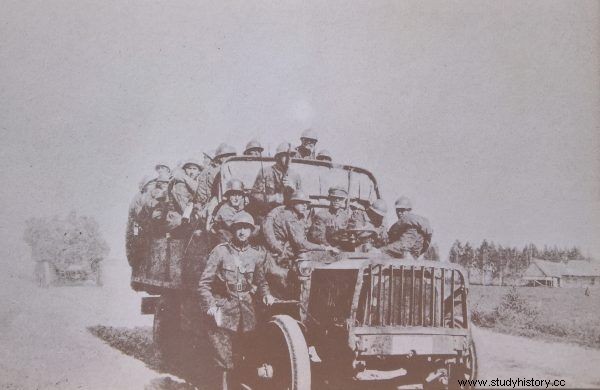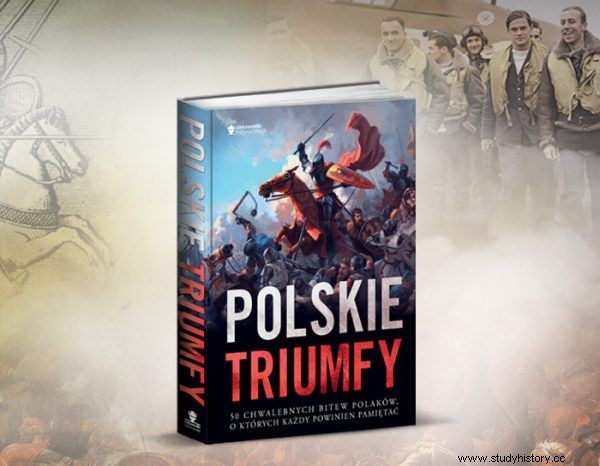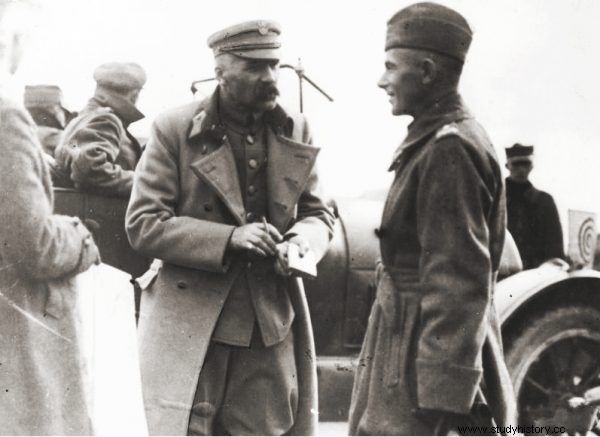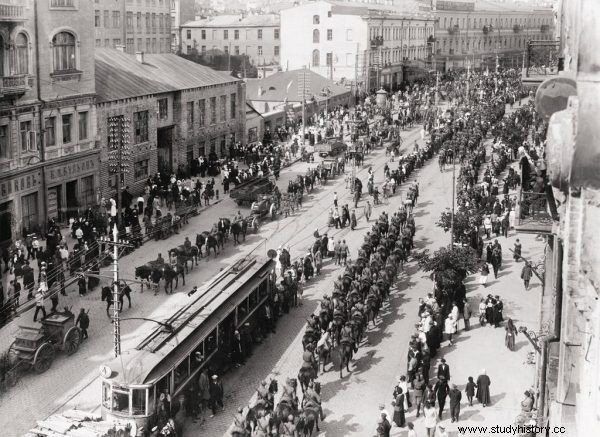The expedition to Ukraine was primarily political. The conquest of Kiev came about by accident, although it is often compared to the achievements of Bolesław the Brave.
The seizure of the Ukrainian capital was to be the icing on the cake of a much wider operation. Its main goal was to maintain an independent Ukrainian state connected with Poland. On the occasion, Piłsudski planned to break up successive Red Armies in order to deal the final blow to the Bolsheviks.
These intentions were closely related to the concept of the Polish Chief, which assumed the creation of a buffer of independent states allied with Poland. According to his plans, independent Lithuania, Belarus and Ukraine would be established to the east of Poland, and would be linked to Warsaw by a military and political alliance. The leader of the state had already started this plan a year earlier by conquering Luninets, Lida, Vilnius and Minsk.
Fast march
Initially, Piłsudski did not plan to capture Kiev. Only a deep cavalry foray, which was tasked with taking Koziatyn, as well as infantry operations to capture Zhytomyr and Berdyczów, was planned. These operations were aimed at "strongly destroying" one of the armies of the South-Western Front, commanded by Alexander Yegorov. What to do next was not considered.
The operation started on April 25, 1920. The pace of the march was unheard of. On the very first day, infantry and cavalry troops achieved all their territorial goals. Only the sub-units of the Soviet 12th Army, which, shortening the front line, withdrew to the east, were not encircled. On April 27, both the Operational Group of General Śmigły-Rydz and the Cavalry Division of Colonel Juliusz Rómmel stopped in the main direction of the attack. The Armies 2 and 6 operating southward also stopped. The commanders did not know what to do next. There were no orders, and Piłsudski was just returning from the Lithuanian-Belarusian section of the front.

Soldiers of the 1st Legions Infantry Regiment during the Kiev expedition.
The attacks were not interrupted only by the units of the Operational Group of Colonel Rybak and General Sikorski's Poleska Group. They were given only auxiliary tasks - their aim was to "bind the local enemy crew with strong attacks of the infantry and the Pinsk flotilla towards Chernobyl". Both officers, seeing that the Soviets were trying to sneak out, moved forward on their own initiative. Polish troops conquered Chernobyl with a strong blow, pushing the enemy as far as the Dnieper line. The land and water roads to Kyiv have been opened.
No plan
Piłsudski did not expect the blow to hit a vacuum. He believed that the Bolsheviks would put up considerable resistance. Meanwhile, the 12th and 14th Armies withdrew practically without a fight, shortening the front and avoiding encirclement. The Commander-in-Chief was in the spot. Due to his aversion to staff members and staff work, no variants of the further part of the offensive were developed at all. The military took up defensive positions and most of the commanders were passively waiting for the situation to develop.
The attacking troops stopped for the day. It was not until the morning of April 28 that Piłsudski issued an "Operational instruction for the General Rydz-Śmigły Group", to which the troops of Colonel Rybak were subordinated. The remaining formations were to remain on the defensive. The Commander-in-Chief probably wanted to provoke the 12th Army into a major battle in this way. But also this time he did not appoint enemy subordinates, but only reaching the designated terrain points.
This order enabled Yegorov to withdraw the disorganized 14th Army and the weakened (due to the defeat of the 44th Rifle Division) 12th Army. The Bolsheviks did not show any willingness to make a decisive confrontation and, protecting the way back, slowly moved their troops to the left bank of the Dnieper. Piłsudski still did not know what to do.

You can read about the victories of our weapon in our latest book "Polish triumphs" . It is the perfect gift for any history buff.
There was another, this time a short, pause in activities. Finally, in the evening of April 28, the Governor ordered General Śmigły-Rydz to continue the march on Kyiv. It was supposed to start only when greater enemy forces would gather around Kiev. Until then, the operation was to be conducted only by aviation. After these orders were issued, Piłsudski left for Belarus, again depriving the troops of the supreme command.
Meanwhile, after the arrival of the 1st Cavalry Army, Budyonny Yegorov changed his operational plans. On May 1, he issued a directive that ordered the 12th Army, in the strength of three infantry divisions and one cavalry division, to bind the greatest enemy forces in the Kiev region. At that time, the 14th Army was ordered to cover the road to Yekaterinoslav and Odessa. Budyonny's troops were left in reserve.
Piłsudski could finally fight the battle he dreamed of.
The Battle That Never Happened
On May 3, a new, 3rd Army was created under the command of Śmigły-Rydz. At the same time, she was ordered to "lead an offensive towards the Dnieper in the sector from the Pripyat River to Krasnaya in order to capture Kiev." The other two Armies were to remain passive. Śmigły-Rydz himself also acted cautiously, maybe even too cautiously. He designated only two divisions for the strike:the 15th Infantry Division and the 1st Legions Infantry Division.

On May 3, Śmigły-Rydz will lead the 3rd Army, whose task was to capture Kiev.
It was only when the 6th Legions Infantry Regiment arbitrarily "attacked the 3rd battalion against the village of Romanówka and with a daring attack carried out from the rear, that the battalion seized the outskirts of Irmienie, breaking the enemy's last defensive line before Kiev," the general fell into consternation. As military historian Lech Wyeszczski wrote:
[…] a paradoxical situation has arisen in the Kiev direction. The reconnaissance already clearly announced that the road to Kiev was free from the enemy, but Piłsudski was still reluctant to issue the final order. [...] It can be assumed that Piłsudski saw the failure of his counts of involving the 12th Army in the fight for Kyiv and tried to delay the confirmation of this fact as long as possible. This disrupted the entire plan of the Ukrainian operation.
On May 6 or 7, 1920, a new variant of the maneuver, aimed at trapping and destroying large enemy forces, had no chance of success.
The commander-in-chief's decisive power stopped the well-developing offensive for the third time in two weeks. Again, acting either too sluggishly or with too little force, he allowed for a peaceful regrouping of the enemy's forces. The decision paralysis of the highest levels of command was released only by the lowest-level officers.

Piłsudski's indecisiveness had a very negative influence on the course of the Kiev operation.
Tram racing
On May 5, a platoon from the composition of Józef Piłsudski's 1st Cavalry Regiment, headed by Lieutenant Olszewski, "captured after a short shooting" a tram coming from the Wodzica Forest - that is, from the forested suburbs of Kiev. At the same time, "a few Russians escorting a rebellious" Erector "were captured.
From these prisoners, Lieutenant Olszewski found out that there was still a school of "krasny" officers in the Wodzica Forest. While sending these important reports, second lieutenant Olszewski manned a tram with several cavalrymen, armed it with one machine gun, and ordered the driver to go to Kiev.
This way they reached Kreszczatik, where they took seven prisoners from the street and returned to their original ambush. At the same time, the platoon of Lieutenant Kosinski enters the suburb of Kiev from Światoszyn, greeted with ovation by the population. Both of these patrols reported that Kyiv was manned by several thousand troops, which our troops did not expect from this direction.
Two days later, Lieutenant Colonel Dąb-Biernacki, commander of the 1st Legions Infantry Brigade, arbitrarily sent another patrol to Kiev.
At 6 o'clock Lieutenant Olszewski set off with his driveway to Kyiv and from the side of the Golden Gate he came to Kreszczatik, greeted with ovation. It was the first branch to enter Kiev. Circle 9 was occupied by the freight and passenger station. A little later, from the side of Kureniowka, he squandered access to the bridge with the fire of machine guns and artillery.

You can read about the victories of our weapon in our latest book "Polish triumphs" . It is the perfect gift for any history buff.
On the news that the city is not properly defended, Dąb-Biernacki decided to send the entire brigade to Kiev:
Around 10.15 am the rest of the regiment of cavalrymen […] arrived amidst a sea of human heads, flowers and cheers of people. Shoes and stirrups were kissed, and Captain Głogowski was handed the keys to the town at the town hall. The enemy tried to send his troops to the bridges several times, probably for destruction purposes, but these were spent with our fire .
The fights continued until late in the evening. Even though “the fight in the city itself was strange; the enemy escaping in trams was also chased by trams, "Kyiv was captured.
When the fighting in Kiev was dying down, an order arrived from the Supreme Commander's Headquarters to start the operation of capturing the city on the next day - May 8 ...

Polish troops enter Kiev in May 1920. Wielka Włodzimierska Street.
Propaganda of success
The capture of Kiev on May 7 in the evening was a surprise for Piłsudski, but it did not prevent the entire operation from being presented as a huge success. And so, in terms of territorial gains, it could and should have been presented directly.
However, strategically, the indecision of the Commander-in-Chief meant that Yegorov could withdraw and regroup his troops without major losses, and after drawing up the reserve and reaching the front of the Mounted Army, he could begin preparations for a counterattack.
***
You can read about the successes of our weapon in the book “Polish triumphs. 50 glorious battles in our history " . Learn about the clashes that changed the course of history with this richly illustrated publication. From victorious fights in the times of Bolesław the Brave, to fierce battles in World War II. Successes that every Pole should remember.
Find out more:
- Bober R., Outline of the war history of the 1st Podhale Rifle Regiment , Military Historical Office, Warsaw 1929.
- Karcz J., Kryński W., An outline of the military history of Józef Piłsudski's 1st Cavalry Regiment , Military Historical Office, Warsaw 1931.
- Łukomski G., Polak B, Wrzosek M., Polish-Bolshevik War 1919-1920 , vol. II, WSI Publishing House, Koszalin 1990.
- Pepłoński A., Interview in the Polish-Bolshevik war 1919-1920 , Bellona, Warsaw 1999
- Skarbek E., Outline of the military history of the 6th infantry regiment of the legions , Military Historical Office, Warsaw 1929.
- Tarkowski K.A., Polish aviation in the war with Soviet Russia 1919-1920, Communication and Communications Publishing House, Warsaw 1991.
- Wyeszczski L., Kyiv 1920 , Bellona, Warsaw 2008.
Check where to buy "Polish triumphs of 50 glorious battles from our history":
